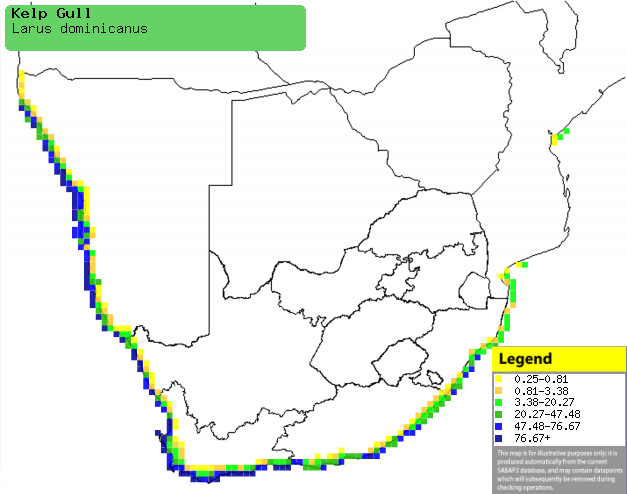|
Larus dominicanus (Kelp Gull, Southern
black-backed gull)
Kelpmeeu, Swartrugmeeu [Afrikaans]; Ingaba-ngaba [Xhosa]; Kelpmeeuw
[Dutch]; Goéland dominicain [French]; Dominikanermöwe [German];
Gaivota-dominicana [Portuguese]
Life
> Eukaryotes >
Opisthokonta
> Metazoa (animals) >
Bilateria >
Deuterostomia > Chordata >
Craniata > Vertebrata (vertebrates) > Gnathostomata (jawed
vertebrates) > Teleostomi (teleost fish) > Osteichthyes (bony fish) > Class:
Sarcopterygii (lobe-finned
fish) > Stegocephalia (terrestrial
vertebrates) > Tetrapoda
(four-legged vertebrates) > Reptiliomorpha > Amniota >
Reptilia (reptiles) >
Romeriida > Diapsida > Archosauromorpha > Archosauria >
Dinosauria
(dinosaurs) > Saurischia > Theropoda (bipedal predatory dinosaurs) >
Coelurosauria > Maniraptora > Aves
(birds) > Order: Charadriiformes
> Family: Laridae > Genus: Larus
Distribution and habitat
Occurs across most of the coastline of the southern
hemisphere, at South America, sub-Antarctic islands, the Antarctic peninsula,
Australia, New, Zealand, Madagascar and the coast of Africa. In southern Africa
it is common along the coast of Namibia and South Africa while scarce in
Mozambique, occupying a variety of marine and coastal habitats (including areas
disturbed my humans)
|
 |
|
Distribution of Kelp gull in southern Africa,
based on statistical smoothing of the records from first SA Bird Atlas
Project (©
Animal Demography unit, University of
Cape Town; smoothing by Birgit Erni and Francesca Little). Colours range
from dark blue (most common) through to yellow (least common).
See here for the latest distribution
from the SABAP2. |
Predators and parasites
- Predators
- Parasites
- Avian cholera (Pasturella multocida)
- botulism caused by the bacterium Clostridium botulinum
Movements and migrations
Juveniles disperse from their parent's
territory once independent, often heading to west-central Namibia
before returning to its natal territory after about a year.
Food
Opportunistic forager and scavenger, with individuals
differing in their diet preference, although it is usually consists of mainly
invertebrates, especially mussels. The foraging techniques employed included the
following:
- scavenges food scraps dropped by fishing ships and Cape fur seals (Arctocephalus
pusillus).
- plucks food items (such as mussels) from the ground and water surface.
- catches swarming crustaceans while swimming.
- plunge-dives from 5 metres above water to catch riverine fish.
- seizes unguarded eggs and chicks from the nests of seabirds.
- treads in shallow water to flush prey.
- catches ducklings attempting to cross open water.
- mobs other birds and steals their food.
- picks up food scraps from rubbish dumps, croplands, fishing harbours and
abattoir.
The following food items have been recorded in its diet:
- Invertebrates
- molluscs
- mussels
- Choromytilus meridionalis (Black mussel)
- Aulocomya ater (Ribbed mussel)
- Mytilus galloprovincialis (Mediterranean mussel)
- Sepia (cuttlefish)
- terrestrial snails
- insects
- alates of Microhodotermes viator (Southern harvester termite)
- isopods
- amphipods
- crabs
- echinoderms
- polychaetes
- sponges
- Lepas (goose barnacles)
- Jasus lalandii (Cape rock lobsters)
- Vertebrates
- frogs
- snakes
- small mammals
- Orctolagus cuniculus (European rabbit)
- carcasses of birds and seals
- eggs and chicks
- Berries
Breeding
- Monogamous, territorial and usually colonial, although it may occasionally
nest solitarily. Pairs typically stay together over multiple breeding
seasons, vigorously defending their nest by dive bombing and defecating on
the intruder.
- The nest is mainly built by the male, consisting of a simple scrape in
the soil lined with grass, twigs, kelp, mollusc shells, large feathers,
jetsam and small stones, typically placed adjacent to a rock, boulder or
wall. Alternatively it may be set into a guano pile or positioned on the roof of a
building.
- Egg-laying season is from September-January.
- It lays 2-4 eggs, which are incubated by both sexes 26-27 days.
- The chicks leave the nest within a few hours of hatching and are brooded
and fed by both parents, fledging at about 46-73 days old. They are
dependent on their parents up to 12 weeks, although they may beg for food
for up to 6 months.
Threats
Not threatened, in fact its has greatly benefited from the
disturbance of habitats by humans, to such an extent that control measures were
put in place in the early 20th century involving the shooting of adults and
poisoning of chicks and eggs. These practices were discontinued in the period
from 1960-1978.
References
-
Hockey PAR, Dean WRJ and Ryan PG 2005. Roberts
- Birds of southern Africa, VIIth ed. The Trustees of the John Voelcker
Bird Book Fund, Cape Town.
|
